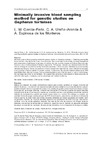Please use this identifier to cite or link to this item:
https://accedacris.ulpgc.es/handle/10553/58226
| DC Field | Value | Language |
|---|---|---|
| dc.contributor.author | García Feria, L.M. | en_US |
| dc.contributor.author | Ureña Aranda, C.A. | en_US |
| dc.contributor.author | Espinosa de los Monteros Zayas, Antonio R. | en_US |
| dc.date.accessioned | 2019-12-03T10:25:53Z | - |
| dc.date.available | 2019-12-03T10:25:53Z | - |
| dc.date.issued | 2015 | en_US |
| dc.identifier.issn | 1578-665X | en_US |
| dc.identifier.other | Dialnet | - |
| dc.identifier.uri | https://accedacris.ulpgc.es/handle/10553/58226 | - |
| dc.description.abstract | La obtención de muestras de tejido de buena calidad es la primera dificultad en cualquier estudio molecular. Esto es especialmente cierto en los estudios de manejo y conservación de la fauna silvestre. En el caso de las tortugas terrestres, la fuente más habitual de ADN son las muestras de sangre obtenidas principalmente de las venas braquial y yugular por contención química, o de individuos conscientes mediante métodos de manipulación y sujeción que pueden causar estrés en el animal. Se requiere una cantidad mínima de sangre para los ensayos del PCR. A continuación, presentamos una técnica mínimamente invasiva que ha resultado eficaz para extraer pequeñas cantidades de sangre apropiadas para realizar análisis genéticos. Además, las muestras obtenidas producen una amplificación de ADN mejor que otras fuentes celulares, como las células epiteliales cloacales. Después de dos años de aplicación en tortugas terrestres silvestres, esta técnica ha demostrado ser inofensiva. Sugerimos que el muestreo de pequeñas cantidades de sangre con esta técnica podría ser útil para otro tipo de análisis, como el seguimiento fisiológico y médico. | en_US |
| dc.description.abstract | Obtaining good quality tissue samples is the first hurdle in any molecular study. This is especially true for studies involving management and conservation of wild fauna. In the case of tortoises, the most common sources of DNA are blood samples. However, only a minimal amount of blood is required for PCR assays. Samples are obtained mainly from the brachial and jugular vein after restraining the animal chemically; or from conscious individuals by severe handling methods and clamping. Herein, we present a minimally invasive technique that has proven effective for extracting small quantities of blood, suitable for genetic analyses. Furthermore, the samples obtained yielded better DNA amplification than other cell sources, such as cloacal epithelium cells. After two years of use on wild tortoises, this technique has shown to be harmless. We suggest that sampling a small amount of blood could also be useful for other types of analyses, such as physiologic and medical monitoring. | en_US |
| dc.language | eng | en_US |
| dc.relation.ispartof | Animal Biodiversity and Conservation | en_US |
| dc.source | Animal biodiversity and conservation [ISSN 1578-665X], v. 38 (1), p. 31-35 | en_US |
| dc.subject | 240990 Citogenética animal | en_US |
| dc.subject.other | Blood extraction | en_US |
| dc.subject.other | DNA source | en_US |
| dc.subject.other | Tortoises | en_US |
| dc.subject.other | Extracción de sangre | en_US |
| dc.subject.other | Fuente de ADN | en_US |
| dc.subject.other | Tortugas terrestres | en_US |
| dc.title | Minimally invasive blood sampling method for genetic studies on Gopherus tortoises | en_US |
| dc.title.alternative | Método de extracción de sangre mínimamente invasivo para estudios genéticos en tortugas terrestres del género Gopherus | en_US |
| dc.type | info:eu-repo/semantics/article | en_US |
| dc.type | Article | en_US |
| dc.identifier.url | http://dialnet.unirioja.es/servlet/articulo?codigo=5043306 | - |
| dc.description.lastpage | 35 | en_US |
| dc.identifier.issue | 1 | - |
| dc.description.firstpage | 31 | en_US |
| dc.relation.volume | 38 | en_US |
| dc.investigacion | Ciencias | en_US |
| dc.type2 | Artículo | en_US |
| dc.contributor.authordialnetid | No ID | - |
| dc.contributor.authordialnetid | No ID | - |
| dc.contributor.authordialnetid | 391583 | - |
| dc.identifier.dialnet | 5043306ARTREV | - |
| dc.utils.revision | Sí | en_US |
| dc.identifier.ulpgc | Sí | en_US |
| dc.contributor.buulpgc | BU-VET | en_US |
| dc.description.sjr | 0,334 | |
| dc.description.jcr | 0,489 | |
| dc.description.sjrq | Q3 | |
| dc.description.jcrq | Q4 | |
| dc.description.sellofecyt | Sello FECYT | |
| dc.description.scie | SCIE | |
| item.grantfulltext | open | - |
| item.fulltext | Con texto completo | - |
| crisitem.author.dept | GIR IUSA-ONEHEALTH 3: Histología y Patología Veterinaria y Forense (Terrestre y Marina) | - |
| crisitem.author.dept | IU de Sanidad Animal y Seguridad Alimentaria | - |
| crisitem.author.dept | Departamento de Morfología | - |
| crisitem.author.orcid | 0000-0002-7736-3139 | - |
| crisitem.author.parentorg | IU de Sanidad Animal y Seguridad Alimentaria | - |
| crisitem.author.fullName | Espinosa De Los Monteros Y Zayas, Antonio | - |
| Appears in Collections: | Artículos | |
Page view(s)
81
checked on Feb 17, 2024
Download(s)
70
checked on Feb 17, 2024
Google ScholarTM
Check
Share
Export metadata
Items in accedaCRIS are protected by copyright, with all rights reserved, unless otherwise indicated.
